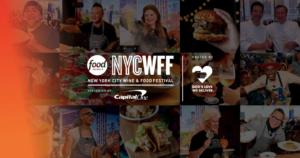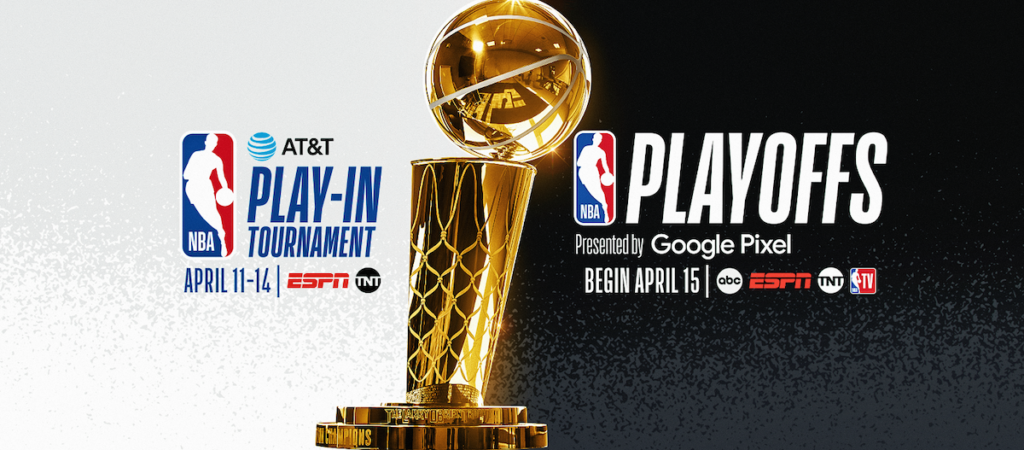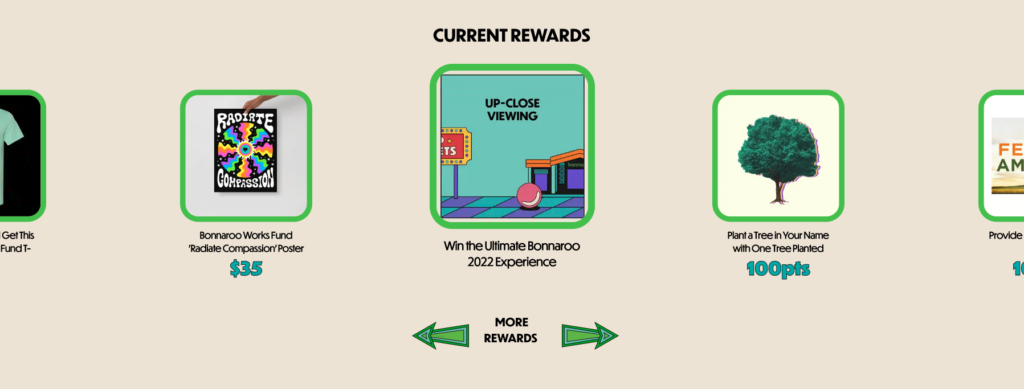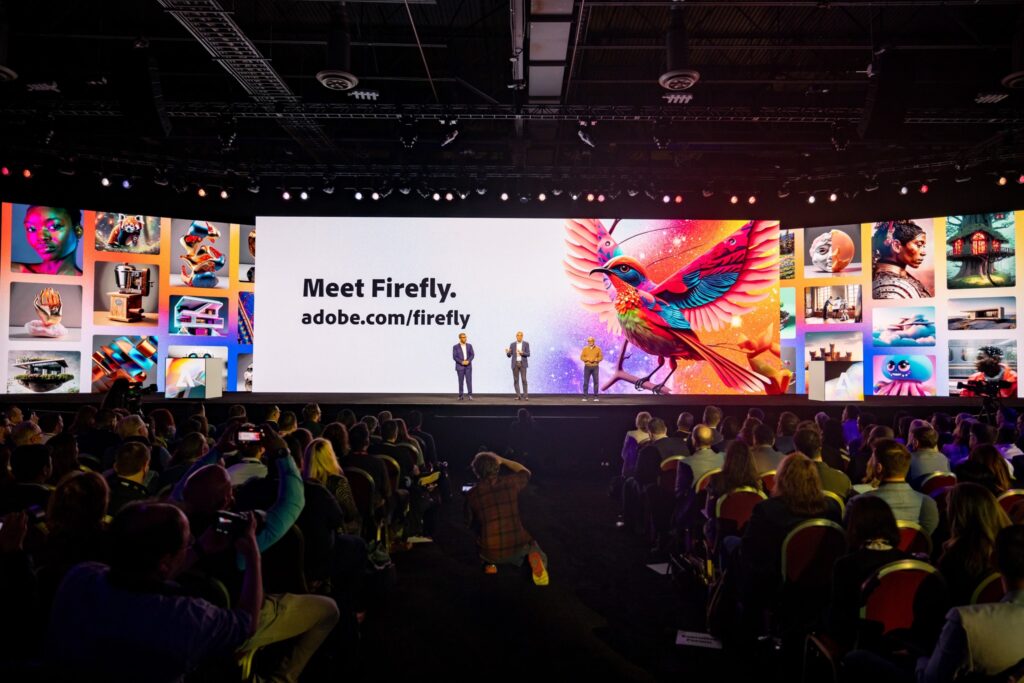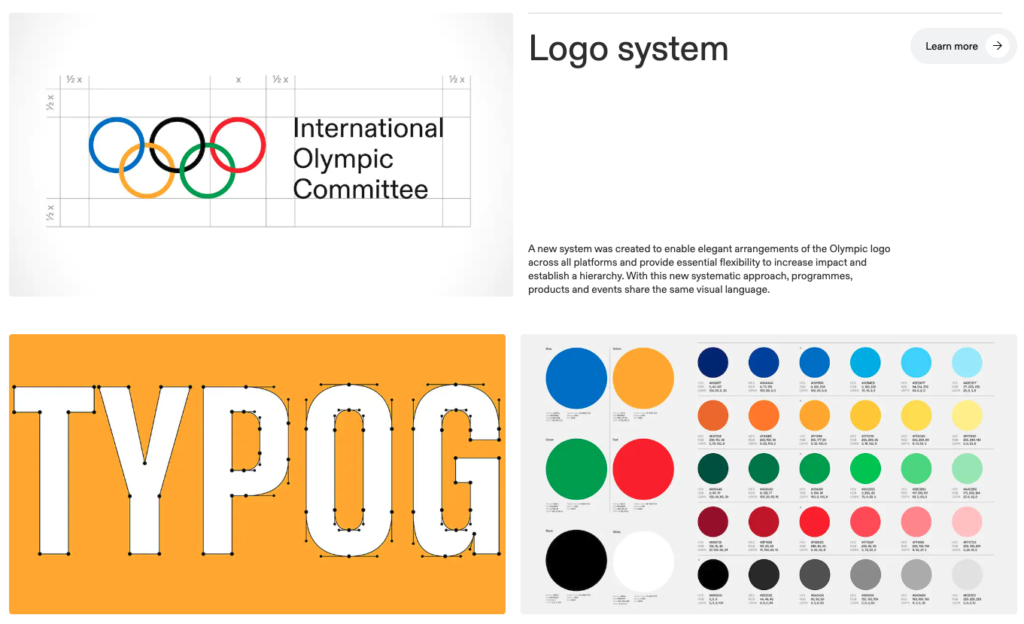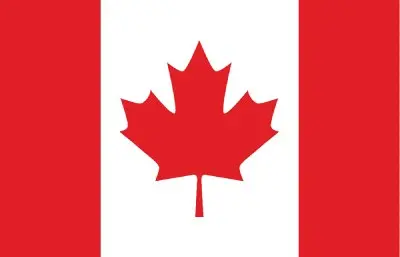Event Branding: Crafting a Memorable Visual Identity for Success
Event branding is essential to hosting successful events, whether it’s a music festival, technology conference, or corporate event. Creating a memorable and cohesive visual identity can make all the difference in how attendees perceive and remember your event.
A solid visual identity can make your event stand out from the competition, capture attendees’ attention, and leave a lasting impression. In this article, we will explore the power of event branding and share tips on creating a visual identity that stands out from the competition.
Why Event Branding Is Important
Your event branding sets the tone for the entire event and is the first thing that attendees see. A solid visual identity can make your event stand out from the competition, capture attendees’ attention, and leave a lasting impression. It can also help you attract sponsors, vendors, and stakeholders, as they can see that your event is well-planned and has a strong sense of branding.
Creating memorable event branding can help make sense of community among attendees. When everyone is wearing or using items with the same branding, it generates a sense of unity and belonging, leading to better engagement and satisfaction among attendees. It can also help attendees remember the event more vividly, as the branding is a visual cue. Finding copyright free images related to your event’s theme can be employed in your visual branding while maintaining affordability and avoiding copyright issues.
To illustrate the importance of event branding, let’s look at some successful past event branding ideas:
Coachella
Music and Arts Festival Coachella is a prime event branding example of a festival with a strong visual identity that resonates with attendees. The festival’s branding has been consistent over the years, with a unique logo that is recognizable and iconic. The bright, bold colors used in the branding evoke a sense of excitement and vibrancy that captures the festival’s energy.
The festival’s merchandise, from t-shirts to hats, uses the same color scheme and logo, creating a cohesive look and feel. Attendees often wear the merchandise during the festival, adding to the sense of community and belonging.
Salesforce
Salesforce’s Dreamforce conference is one of those event branding examples where the event branding is done just right. The conference’s branding is consistent across all touchpoints, from the website to the event signage and merchandise. Using bold, bright colors and simple yet effective messaging creates a sense of excitement and unity among attendees.
Salesforce also uses social media to its advantage, sharing updates and behind-the-scenes glimpses leading up to the event. The company encourages attendees to share their experiences using the conference’s branding and social media hashtags, creating a sense of online and offline community.
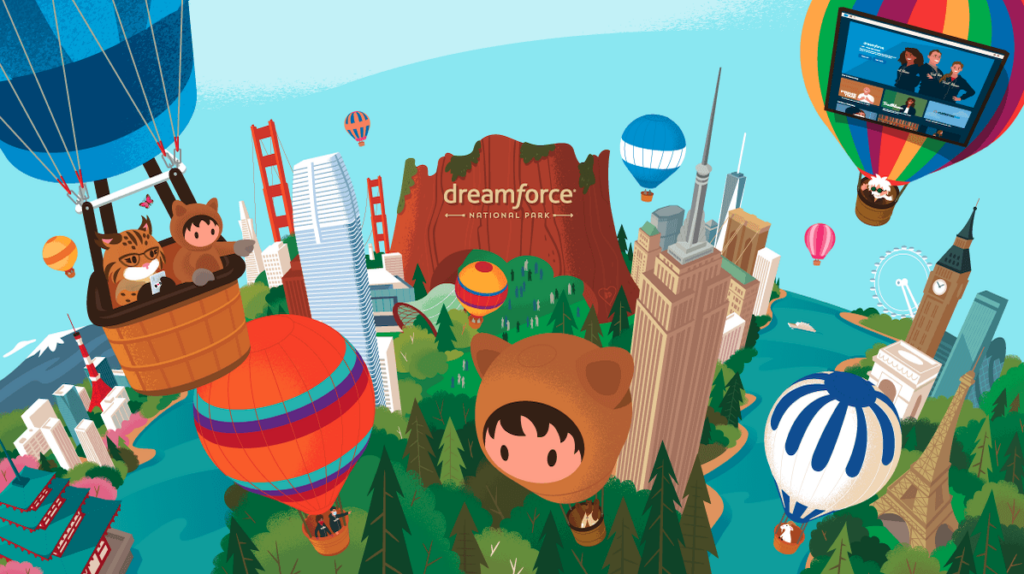
New York City Wine and Food Festival
This festival takes place annually and has a cohesive visual identity consistent across all touchpoints. The festival’s branding features a distinctive logo with a simple, modern design that reflects the event’s focus on food and wine.
The color palette is also consistent with the event’s theme, using warm, inviting red and orange hues that evoke warmth and comfort. The merchandise, such as aprons and wine glasses, features the same logo and color palette, creating a cohesive and recognizable look and feel.
In addition, the festival uses social media to promote the event and engage with attendees. Their Instagram account shares behind-the-scenes glimpses of the event with photos and videos of the food and wine available. The festival also encourages attendees to share their experiences on social media, using the event’s branded hashtags and handles.
The New York City Wine and Food Festival is an excellent example of how effective event branding can help create a cohesive and memorable event. Using a clear and consistent visual identity and leveraging social media to engage with attendees. The festival has become one of the world’s most popular food and wine event branding examples.
Event Branding Ideas to Create a Memorable Event Branding
Now that we’ve established the importance of event branding, let’s dive into some tips for creating a memorable and cohesive visual identity.
Start with a Clear Concept or Theme
After realizing the significance of event branding and the essential elements of establishing an impactful and consistent visual identity, the next step is to focus on your event’s concept or theme.
Your concept or theme should be the foundation for all your branding decisions, from the color palette to the messaging. It should also be related to the event or a more abstract idea that resonates with your target audience.
When choosing a concept or theme, consider the following:
- Event Type: What event are you hosting? Is it a music festival, a technology conference, or a corporate event? The event type will help guide the theme and tone of your branding.
- Target Audience: Who is your target audience? What are their interests and values? The theme should be relevant and appealing to your target audience.
- Venue: Where is the event taking place? The platform can inspire the theme and tone of your branding.
- Competition: What are your competitors doing? How can you differentiate your event branding from theirs?
Some event branding examples of successful branding themes:
- Music festival: Celebration, Freedom, Escape
- Technology conference: Innovation, Disruption, Future
- Corporate event: Professionalism, Networking, Growth
Remember, your concept or theme should be clear and easy to communicate. It should also guide your branding decisions and help create a cohesive visual identity.
Use Color Psychology to Your Advantage
Color psychology studies how colors affect human behavior and emotions. By understanding color psychology, you can choose the right ones for your event branding to elicit certain feelings and create a specific mood or tone.

Here are some standard colors and the emotions they can evoke:
- Red: Excitement, urgency, passion
- Blue: Calmness, trust, professionalism
- Green: Nature, growth, health
- Yellow: happiness, optimism, warmth
- Purple: Creativity, luxury, imagination
- Orange: Energy, playfulness, warmth
- Black: Sophistication, power, elegance
- White: Purity, simplicity, cleanliness
When choosing your color palette, consider your concept or theme and the emotions you want to evoke in attendees. You can also use color psychology to highlight specific branding elements, such as using red to draw attention to important information.
It’s fundamental to note that cultural differences can also affect the emotions and meanings associated with colors. Make sure to research the cultural associations of colors if your event has a diverse audience.
In addition to color, typography, and imagery can also contribute to the mood and tone of your branding. Ensure all your branding decisions align with your concept or theme to create a cohesive visual identity.
Be Consistent Across All Touchpoints
Consistency is vital in event branding. Having a logo and some merchandise with your event’s name is not enough. Your visual identity should be consistent across all touchpoints, from the website to the event signage and merchandise. This consistency helps reinforce your brand and make it more memorable to attendees.
One way to ensure consistency is to create a brand style guide. A brand style guide is a document that outlines the rules for using your brand’s visual elements, such as colors, typography, and imagery. It provides guidelines on using these elements in a way consistent with your brand’s voice and personality. This guide should be distributed to all stakeholders involved in the event, including designers, marketers, and event staff.
Tips for Creating Your Brand Style Guide
When creating your brand style guide, consider the following:
- Color palette: Choose a color palette consistent with your brand’s personality and tone. Use this color palette consistently across all your branding materials.
- Typography: Choose a set of fonts that work well together and use them consistently across all your branding materials.
- Imagery: Choose imagery that reflects your brand’s personality and tone. This includes photographs, illustrations, and other visual elements.
- Voice and tone: Define your brand’s voice and style, and use it consistently across all your branding materials. This includes your website, social media channels, and event materials.
Having a clear vision for your event’s branding is also essential. This vision should guide all decisions related to the event’s branding, from logo design to merchandise selection. Having a clear vision and guidelines, you can ensure that your event branding is consistent and memorable.
To illustrate the importance of consistency in event branding, let’s look at an example from the world of sports. The NBA has a strong visual identity that’s consistent across all touchpoints. The league’s logo features a stylized basketball, used consistently across all branding materials, from the website to the merchandise. The league’s color palette is also consistent, with a primary color of red and secondary shades of blue and white. This consistency has helped make the NBA one of the world’s most recognizable and successful sports leagues.
In addition to creating a brand style guide and having a clear vision for your event’s branding, it’s also important to be open to feedback and make adjustments as needed. Be bold and ask attendees and stakeholders for their thoughts on your branding, and be willing to make changes based on their feedback.
You can create a lasting impression on attendees and stakeholders by prioritizing consistency in your event branding. A strong, cohesive visual identity can help set your event apart from the competition and make it more memorable for attendees.
Create Custom Merchandise
Custom merchandise is a powerful event branding idea to extend your branding beyond the event. Attendees can wear or use items with your branding on them, acting as walking advertisements for your event. Moreover, custom merchandise can generate additional revenue for your event. This section will explore the best practices for creating custom merchandise and how it can benefit your event.
Keep Your Branding Consistent
When designing custom merchandise, it’s crucial to keep your branding consistent. Use the same color palette, typography, and imagery as your other branding elements. Consistency reinforces your brand and makes it more memorable. Moreover, this creates a cohesive look and feel that attendees will associate with your event.
For example, let’s consider the New York Comic Con merchandise. They use the same bold colors and typography throughout their branding and merchandise. They have t-shirts, hoodies, bags, and more that use the same colors and typography, creating a consistent and cohesive look.
Consider the Practicality and Desirability of the Merchandise
It’s necessary to consider the practicality and desirability of your merchandise. Items such as t-shirts, hats, and tote bags are popular, but you can get creative with water bottles, phone cases, and even temporary tattoos.
For example, at the South by Southwest (SXSW) festival, they offered custom socks as part of their merchandise. The socks were unique and practical, giving attendees a valuable item while promoting the event.
Use Custom Merchandise as a Reward
Custom merchandise can also reward attendees for their engagement and participation. For example, you can offer exclusive merchandise to attendees who complete specific actions, such as attending several sessions or sharing their experience on social media.
For instance, the famous music festival Bonnaroo offers a loyalty program called “Bonnaroo Rewards.” Festival-goers earn points for various activities, such as attending past festivals, purchasing tickets early, and engaging with Bonnaroo on social media. These points can be redeemed for exclusive merchandise like t-shirts, hats, and water bottles.
Offer Sponsors and Vendors Branded Items for Events
In addition to offering attendees custom merchandise, you can deliver branded items for events to sponsors and vendors, increase their visibility and generate additional revenue for your event. Moreover, offering branded items for events, like merchandise, can also strengthen your relationship with them.
For example, the popular technology conference, Web Summit, offers custom merchandise to its sponsors. By doing this, they allow sponsors to promote their brand and engage with attendees while generating additional revenue for the conference.
By offering branded items consistent with your event branding and desirable to attendees, you can create a lasting impression of your event and increase engagement and revenue.
Use Social Media to Your Advantage
In today’s digital age, social media is a powerful tool for event branding. Platforms like Twitter, Facebook, Instagram, and LinkedIn allow you to reach a wider audience and engage with attendees before, during, and after the event.
To use social media effectively:
- Create a strategy that aligns with your branding goals.
- Determine which platforms you want to use and how often you’ll post.
- Consider creating a social media calendar to plan your posts in advance.
Encourage attendees to use your event hashtag when posting on social media during the event. This way, you will help create buzz around your event and extend your branding reach. You can also use social media to share real-time updates, photos, and videos from the event, giving followers who aren’t attending a taste of the experience.
After the event, continue engaging with attendees and sharing highlights on social media. This can help keep the momentum going and create anticipation for future events.
More Event Branding Examples: Adobe Summit
The Adobe Summit is an annual conference for digital marketing professionals. The forum uses social media extensively to promote the event, engage with attendees, and extend its branding reach.
Leading up to the event, Adobe Summit creates a social media campaign that includes a custom hashtag (#AdobeSummit) and shares updates and behind-the-scenes glimpses on Twitter, LinkedIn, Facebook, and Instagram.
Adobe Summit encourages attendees to use the hashtag during the event when sharing their experiences on social media. The conference also live streams keynote speeches and other sessions on social media, allowing followers who aren’t attending to participate virtually.
After the event, Adobe Summit continues to engage with attendees and share highlights on social media, which helps create buzz for the following year’s event and keeps the conference top-of-mind for attendees.
Work with a Professional Designer
Creating a unique and cohesive event branding strategy requires much work and expertise. While developing your branding in-house may be tempting, working with a professional designer can help take your branding to the next level.
A professional designer can bring fresh ideas and perspectives to the table and has the technical skills and knowledge needed to execute a cohesive visual identity across all touchpoints. They can also help ensure that your branding is consistent, memorable, and resonates with your target audience.
When working with a professional designer, communicate your branding goals and provide clear feedback. It’s also indispensable to establish a clear timeline and budget and be open to the designer’s input and suggestions.
Here’s an Example: The Olympics
The Olympics is one of the most recognizable and successful examples of event branding. The Olympic rings logo, created by Pierre de Coubertin in 1913, is an iconic symbol of the event and is instantly recognizable worldwide.
The International Olympic Committee (IOC) works with a team of professional designers to create a cohesive and memorable visual identity for each Olympic Games. The branding is consistent across all touchpoints, from the website and social media to the event signage and merchandise.
Working with professional designers has helped the IOC create a solid and recognizable brand that resonates with audiences worldwide. The branding has become a symbol of unity and athleticism and has helped make the Olympics one of the world’s most prestigious and highly anticipated events.
Measure the Success of Your Event Branding
Measuring the success of your event branding is crucial to understand the impact it has on attendees and stakeholders. There are a few ways to measure the success of your branding efforts:
Surveys
Send out surveys to attendees and stakeholders to gather feedback on the event branding. Ask specific questions about the effectiveness of the branding, what attendees remembered most, and how it impacted their experience.
Social Media Engagement
Monitor social media engagement around your event branding. Look at the number of likes, shares, and mentions to see how your branding resonated with attendees.
Sales of Custom Merchandise
Track the sales of custom merchandise to understand how attendees engaged with your branding beyond the event itself.
Sponsorship and Vendor Feedback
Gather feedback from sponsors and vendors to understand how they perceive your event branding. This feedback can help you make adjustments for future events.
By measuring the success of your event branding, you can make informed decisions for future events and continue to improve your branding strategy.
Conclusion
Event branding is crucial to hosting a successful event. Creating a memorable and cohesive visual identity can capture attendees’ attention, leave a lasting impression, and attract sponsors, vendors, and other stakeholders.
To create a compelling event branding strategy:
- Establish a clear concept or theme that guides all your branding decisions.
- Consider your audience and the emotions you want to evoke in them when selecting your color palette and typography.
- Use color psychology to your advantage, choosing colors that elicit the desired emotions and mood.
Consistency is critical when it comes to event branding. Ensure your visual identity is consistent across all touchpoints, including the website, social media, signage, and merchandise. This consistency reinforces your brand and makes it more memorable to attendees.
Working with a professional designer can help you create a polished and professional look for your event branding. A designer can make sure your branding is consistent, on-brand, and visually appealing across all touchpoints.
Finally, measuring the success of your event branding efforts is essential. Analyse attendee satisfaction, social media engagement, and merchandise sales metrics to make informed decisions for future events.

